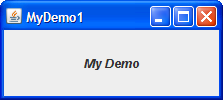Questions and Exercises: Using Swing Components
Use the information in this lesson and the component how-to sections to help you complete these questions and exercises.
Questions
1. Find the component that best fits each of the following needs. Write down both the component’s common name (such as “frame”) and find the component's how-to page online. [Hint: You can use A Visual Index to the Swing Components to help you answer this question.]
a. A component that lets the user pick a color.
b. A component that displays an icon, but that doesn’t react
to user clicks.
c. A component that looks like a button and that, when pressed,
brings up a menu of items for the user to choose from.
d. A container that looks like a frame, but that appears (usually
with other, similar containers) within a real frame.
e. A container that lets the user determine how two components
share a limited amount of space.
2. Which method do you use to add a menu bar to a top-level
container such as a JFrame?
3. Which method do you use to specify the default button for
a top-level container such as a JFrame or JDialog?
4. Which method do you use to enable and disable components
such as JButtons? What class is it defined in?
5. a. Which Swing components use ListSelectionModel?
[Hint: The “Use” link at the top of the specification
for each interface and class takes you to a page showing where
in the API that interface or class is referenced.]
b. Do those components use any other models to handle other aspects of the components’ state? If so, list the other models’ types.
6. Which type of model holds a text component’s content?
Exercises
1. Implement a program with a GUI that looks like the one
shown below. Put the main method in a class named MyDemo1.

2. Make a copy of MyDemo1.java named MyDemo2.java.
Add a menu bar to MyDemo2.
3. Copy MyDemo1.java to MyDemo3.java.
Add a button (JButton) to MyDemo3.java.
Make it the default button.
Check your answers.
